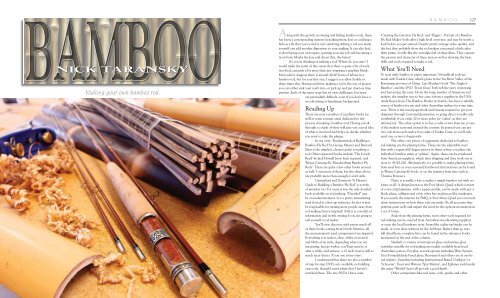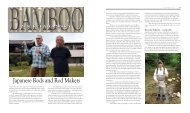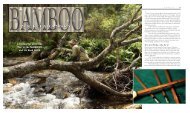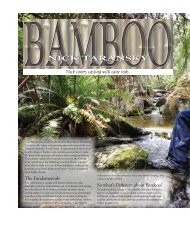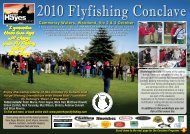Issue #10 (Making your own rod) - NA Taransky Bamboo Rods
Issue #10 (Making your own rod) - NA Taransky Bamboo Rods
Issue #10 (Making your own rod) - NA Taransky Bamboo Rods
- No tags were found...
You also want an ePaper? Increase the reach of your titles
YUMPU automatically turns print PDFs into web optimized ePapers that Google loves.
126 FLYFISHER BAMBOO 127Nick <strong>Taransky</strong><strong>Making</strong> <strong>your</strong> <strong>own</strong> bamboo <strong>rod</strong>.Along with the growth in <strong>own</strong>ing and fishing bamboo <strong>rod</strong>s, therehas been a corresponding interest in making them. Just as catching afish on a fly that you’ve tied is very satisfying, fishing a <strong>rod</strong> you made<strong>your</strong>self can add another dimension to <strong>your</strong> angling. It can also leadto developing <strong>your</strong> <strong>own</strong> tapers, quitting <strong>your</strong> day job and becoming atrout bum. Maybe the less said about that, the better!So, you’re thinking of making a <strong>rod</strong>. Where do you start? Iwould make the point at the outset that there is quite a bit of workinvolved, certainly a lot more than just wrapping a graphite blank.Most advice suggests there is around 40-60 hours of labour in abamboo <strong>rod</strong>, but for <strong>your</strong> first one, I suggest you allow double orthree times this. Having said that, making a <strong>rod</strong> is the sort of projectyou can either sink <strong>your</strong> teeth into, or pick up and put d<strong>own</strong> as timepermits. Each of the many steps has its <strong>own</strong> challenges, but noneare particularly difficult, even if you don’t have awoodworking or handyman background.Reading UpThere are now a number of excellent books (aswell as some average ones) dedicated to theprocess of making a bamboo <strong>rod</strong>. Having a lookthrough a couple of these will give you a good ideaof what is involved and help you decide whetheryou want to take the plunge.In my view, ‘Fundamentals of Building a<strong>Bamboo</strong> Fly Rod’ by George Maurer and BernardElser is the simplest, clearest guide to making a<strong>rod</strong>. Other respected books include ’The LovelyReed’ by Jack Howell (now back in print), andWayne Cattanach’s ‘Handcrafting <strong>Bamboo</strong> Fly<strong>Rods</strong>’. There are quite a few other books aroundas well. I <strong>own</strong> most of them, but the three aboveare probably more than enough to start with.Carmichael and Garrison’s ‘A Master’sGuide to Building a <strong>Bamboo</strong> Fly Rod’ is worthyof mention too. For years it was the only detailedbook available on <strong>rod</strong> making. “Detailed” maybe an understatement. It is a pretty intimidatingread if used as a first-up reference. In fact it maybe responsible for turning more people away from<strong>rod</strong> making than it inspired! Still, it is a wealth ofinformation and worth <strong>own</strong>ing if you are going tocall <strong>your</strong>self a <strong>rod</strong> maker.You’ll soon discover, with pretty much allof these books coming from North America, allthe measurements (and components) are imperial.Everything is in inches, thou, 16ths of an inchand 64ths of an inch, depending what you aremeasuring. Just go with it, you’ll get used to itafter a while, and anyway, a 12 inch trout is still somuch nicer than a 30 cm one in my view!I understand that there are also a numberof step-by-step DVDs sets available on buildingcane <strong>rod</strong>s, though I must admit that I haven’twatched these. The two DVDs I have seen,‘Creating the Garrison Fly Rod’, and ‘Digger – Portrait of a <strong>Bamboo</strong>Fly Rod Maker’ both offer a high level overview, and may be worth alook before you get started. Despite pretty average video quality, andthe fact they probably show the <strong>rod</strong> makers concerned a little aftertheir prime, I really like the nostalgic feel of these films. They capturethe passion and character of these men as well as showing the basicskills and tools required to make a <strong>rod</strong>.What You’ll NeedTo start with, bamboo is pretty important! Virtually all <strong>rod</strong>s aremade with Tonkin Cane, which grows in the Sui River Valley of theKwantung province of China. Luis Marden’s book ‘The Angler’s<strong>Bamboo</strong>’, and the DVD ‘Trout Grass’ both tell the story of growingand harvesting the cane. Given the large number of American <strong>rod</strong>makers, the simplest way to buy cane is from a supplier in the USA.Andy Royer, from The <strong>Bamboo</strong> Broker in Seattle, has been a reliablesource of bamboo for me and other Australian makers for some timenow. There is the usual paperwork and ransom required to get <strong>your</strong>shipment through Customs/Quarantine, so going direct is really onlyworthwhile if you order 20 or more poles (or ‘culms’, as they arereferred to). The other option is to buy a culm or two from me or oneof the makers scattered around the country. In general you can gettwo <strong>rod</strong>s from each twelve foot culm of Tonkin Cane, so you’ll onlyneed one or two to begin with.The other core pieces of equipment dedicated to bamboo<strong>rod</strong> making are the planing forms. These are the adjustable steelbars with a tapered 60 degree groove in them, where you plane theindividual bamboo strips or ‘splines’. Again, these can be purchasedfrom American suppliers, which after shipping and duty work out atclose to AU$2,000. Alternatively, it’s possible to make planing formsfrom steel bars or even seasoned hardwood. Instructions can be foundin Wayne Cattanach’s book, or on the internet from sites such asThomas Penrose’s.There is actually a way to make a simple bamboo <strong>rod</strong> with noforms at all. A design kn<strong>own</strong> as the Poor Man’s Quad, which consistsof a two strip laminate, with a square profile, can be made with just ablock plane, callipers and a few other bits and pieces like sandpaper.If you search the internet for PMQ or Poor Man’s Quad you can trackd<strong>own</strong> instructions on how these <strong>rod</strong>s are made. By all accounts theyperform quite well, and negate the need for the upfront investment ina set of forms.Aside from the planing forms, most other tools required for<strong>rod</strong> making can be sourced from Australian woodworking suppliersor even the local hardware store. Items like a glue-up binder can bemade, or even done without for the hobbyist. Rather than go intofull detail here, complete lists can be found in the reference booksmentioned at the end of the column.Similarly, a variety of waterproof glues and marine glossvarnishes suitable for <strong>rod</strong> making are readily available from localAustralian sources. For glue, several epoxies including West System,Urea Formaldehyde based glues, Resorcinol and others are in use by<strong>rod</strong> makers. Varnishes including International Brand ‘Goldspar’ or‘Schooner’, Feast and Watson ‘Spar Marine’, and Epifanes (sold underthe name ‘Werdol’ here) all provide a good finish.Other components like reel seats, cork, guides and other
128 FLYFISHER BAMBOO 129hardware, can be bought from a number of suppliers in the USA. Ialso keep a reasonable stock for my <strong>own</strong> use that I sell locally too.Choosing a TaperThe reference books all contain a selection of tapers to choose fromwhen making <strong>your</strong> first <strong>rod</strong>. My advice is to go with something like a 7to 7½ foot, 4 or 5 weight. Also, I’d suggest choosing a taper with a tipthat isn’t too fine: at least 60 thousands of an inch or more.Additionally, I recommend starting with a two piece <strong>rod</strong>,rather than three (or more). Believe me, you’ll have enough funpreparing, tuning and fitting ferrules on a two piece <strong>rod</strong> without thetruncated and extra-small top ferrule on a three piece <strong>rod</strong>.After <strong>your</strong> first <strong>rod</strong> or two, you may want to try a three piece<strong>rod</strong>, or start tweaking existing tapers to suit <strong>your</strong> fishing style or <strong>your</strong>local waters. The possibilities are endless and it’s a lot of fun.An Overview of Rod <strong>Making</strong>The reference books I’ve mentioned are dedicated to the process ofmaking a <strong>rod</strong>, so I won’t go into too much detail here. However it’sworth broadly going over the major tasks just to give an idea of how a<strong>rod</strong> is put together.Starting with a 12 foot culm of bamboo, the culm may beflamed (to stiffen it and enhance colour), and then cut d<strong>own</strong> to thelength of the <strong>rod</strong> sections (plus some overlap). It is then split into thin(5-10mm) strips. The nodes (growth rings) on the outside are filedor sanded (and may also be pressed), making the outside of the stripflat. The enamel on the outside is also removed via sanding or filing toreveal, but not damage, the dense power fibres beneath. The strips arestraightened and maybe further oven tempered.Six strips are then identically tapered/shaped into equilateraltriangle profiles to form each section of the <strong>rod</strong> (with maybe morekilning part way through to set the strips true and straight, andstiffen them further). As an aside, the planing of all the sectionsof a <strong>rod</strong> can take more than 5,000 passes of the plane – somethingfor anyone at risk of RSI and joint fatigue to be aware of! Theseplaned strips or ‘splines’ are then glued together to form a hexagonallaminate for each <strong>rod</strong> section. The excess glue is removed from theblank, the sections are trimmed to length, and metal ferrules areprepared and mounted. The cork grip is glued together, shaped, andmounted on the <strong>rod</strong> along with the reel seat hardware. The <strong>rod</strong> isvarnished (several coats), guides are wrapped on and the wraps arealso varnished with multiple coats. A final polish and wax and voila! –you’re ready to go fishing. That wasn’t so hard, was it?This of course is the briefest of overviews, covering most of thebasic steps, but missing much of the detail. Buy a reference book ortwo and have a read. One thing that reading up and talking to othermakers will demonstrate, is there are many slightly different waysand sequences when making a <strong>rod</strong>. Don’t get too bogged d<strong>own</strong> orconfused agonising over which method is best. Pick one of the booksand follow it through.Getting HelpThere are makers now right across Australia, from newcomers todiehard enthusiasts. Most of these people are passionate about <strong>rod</strong>making and are more than willing to lend a hand to those starting out.Please understand though that some makers may be busy and mightneed their spare time to finish their <strong>own</strong> <strong>rod</strong>s too!The Victorian Fly Fisher’s Association (www.vffa.org.au)holds a Cane Day every winter. The turnout is growing every year.It’s an opportunity for lovers of bamboo <strong>rod</strong>s – old and new – to gettogether for a cast and a chat. More makers are present every yearand it’s a really good opportunity to see and cast a lot of different<strong>rod</strong>s. In the last couple of years, the weekend has been expanded toinclude a ‘Maker’s Day’ on the Saturday before the wider ‘Cane Day’on Sunday. It is a worthwhile trip to Melbourne for the weekend foranyone interested in Cane.Internet forums are another potential source of help. I’vecome across some excellent cane <strong>rod</strong> making tips on-line, includingsome from generous and knowledgeable Australian makers like PeterMcKean. I’ve also seen some ‘advice’ that should never have beenoffered! My advice is to take the forum route if you like, but if indoubt, stick with the books while you are finding <strong>your</strong> feet.I am trying to make time (between building <strong>rod</strong>s and fieldtesting – a tough job…) to organise a live-in <strong>rod</strong> making class.Attendees would spend a week as a small group of three or four, eachlearning the <strong>rod</strong> making process and finishing up with a <strong>rod</strong> at the endof it. This is how I got started with American master Jeff Wagner. Itwill take a while to fit it into my schedule, but keep an eye out on mywebsite for information.Summing Up<strong>Making</strong> <strong>rod</strong>s won’t be for everyone. In this time poor era, it can beenough of a challenge just getting out for a fish. Believe it or not Isuffer from this malady too, more than I care to admit. Rod makingis a craft though that you can pursue at <strong>your</strong> <strong>own</strong> pace, in <strong>your</strong> <strong>own</strong>home or garage. It’s rewarding in its <strong>own</strong> right and you’d be surprisedhow well even <strong>your</strong> first <strong>rod</strong> will fish.FACT FILEThere are many suppliers and sources of information, tools,materials and components. Listed here are a few that I havefound reliable and that will set you on the right track.BooksFundamentals of Building a <strong>Bamboo</strong> Fly-Rod (Countryman Press)George Maurer and Bernard ElserAn excellent, simple guide. Start with this one.The Lovely Reed (Howell Handmade) Jack HowellA highly regarded reference, recently back in print after years of out-ofprintcopies commanding $400 plus prices.Handcrafting <strong>Bamboo</strong> <strong>Rods</strong> (Lyons Press) Wayne CattanachAnother respected how-to book, including instructions on how to make aset of planing forms.A Masters Guide to <strong>Making</strong> a <strong>Bamboo</strong> Fly Rod (Meadow RunPress) Everett Garrison & Hoagy CarmichaelA definitive guide!Courses, Planing Forms, all <strong>rod</strong> makingtools and componentsJ D Wagner Rod makers (Ohio, USA—www.wagner<strong>rod</strong>s.com)Jeff and his partner Casimira are wonderful people to deal with, and offerall the tools and components you need to make a <strong>rod</strong>. Their <strong>rod</strong> makingcourse is also highly recommended if you can make the trip to the USA.Classic Sporting Enterprises(Ferrules, reel seats and other tools and components)214 Higgins Lane, Barton Vermont 05822 USA (802) 525 3623CSE have set the standard in bamboo <strong>rod</strong> hardware for decades. Nowebsite (they are too busy making components to be on the net), butgive Bailey or Steve a call and they will help you out.Bellinger Inc. —www.genuinebellinger.comReel seats, hardware, and tools.<strong>Bamboo</strong>The <strong>Bamboo</strong> Broker—www.bamboobroker.comAndy Royer sends to Australia frequently and I carry his maker’s gradeTonkin Cane for resale here too.Charles H Demarest Inc.—www.tonkincane.comDemarest have supplied the bamboo <strong>rod</strong> industry in the USA since itsinception over 100 years ago.<strong>Bamboo</strong> <strong>rod</strong> maker Nick <strong>Taransky</strong> lives in Queanbeyan, near the streams of the Monaro and Snowy Mountains.Visit www.taranskybamboo.com.au


